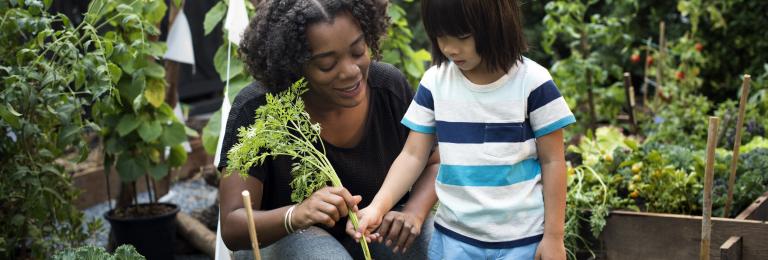Gardening with Kids
Getting young children involved with gardening is a great way to connect with nature and improve food literacy by helping them understand how food grows. They also get to use all of their senses and some fundamental movement and fine motor skills by digging in the earth, manipulating seeds, observing the changes as the plants grow and hopefully even tasting the food (children are often more keen to try something they have helped grow or prepare). Early spring is a great time to start seeds indoors and talk to children about our growing season.
Here is what you need to do:
- Determine if you will be growing plants outside or only inside. If you do have room outside for a small garden or planter, have children help prepare the soil by weeding, tilling with shovels or sticks and stirring in compost or other natural soil additions (*avoid chemical fertilizers which can be toxic if ingested from children’s hands).
- Choose your seeds. Decide what types of vegetables or beans you could grow depending on the space and sunlight you have. Squash need to spread their vines along the ground so need more room like a large planter or garden plot. Tomatoes, herbs, lettuce, chard and kale grow more vertically and can be done in pots. Beans and peas need a trellis or fence to grow up along. Save the seed packets to remind yourself of the growing requirements.
- Start seeds inside by sprouting them in moist paper towels inside small plastic bags. Have the children choose (ideally) two types of seeds to start, just in case one doesn’t make it. Place these in a sunny window. Check daily to ensure towel stays moist and to watch for the seed to open.
- Once sprouted, move to a small pot or an empty paper egg carton with some fresh potting soil (choose soil that is specifically for growing food plants). Egg cartons work well as they can be planted right into a bigger pot or the garden and the paper will eventually break down (*this won’t happen with Styrofoam egg cartons).
- Move seedlings outdoors (if you can) once no risk of frost remains. Some plants may need to stay warmer longer, like tomatoes. Some plants may need stakes to help support them.
- Have children take turns playing different roles of the gardener, like watering, weeding and eventually picking the veggies. If your crop doesn’t end up quite big enough for everyone to try some, simply supplement with some extra from the grocery store. Consider a taste test to see which tastes better!
More Resources
http://www.cbc.ca/parents/play/view/planting-an-edible-garden-with-kids
http://www.canadianliving.com/food/food-tips/article/5-kitchen-herbs-kids-can-grow-themselves
